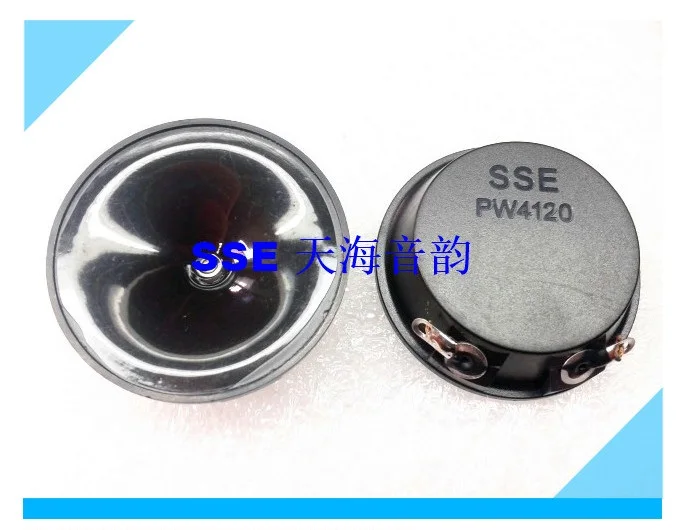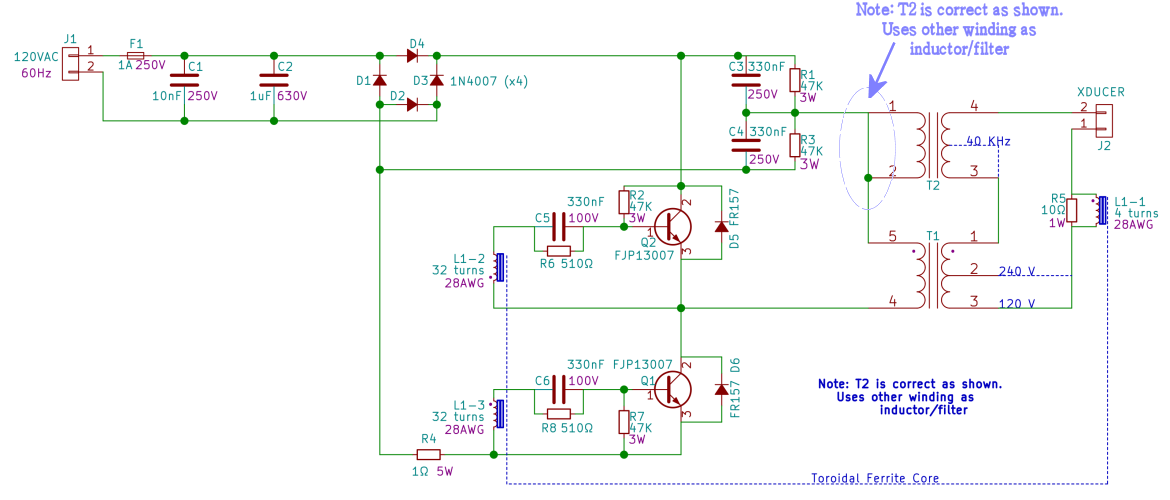- High Power Ultrasonic Speaker
- Ultrasonic Speaker Driver Reviews
- Ultrasonic Speaker Drivers
- 8 Ohm Piezo Speaker
- Ultrasonic Amplifier Circuit
I am attempting to build a cat deterrent with an Arduino, something akin to this. I have figured out detection, and now realize that I need to use an ultrasonic transducer to produce the 'blast' that I need.
Cheap Ultrasonic Range Finder based on PIC16F877A with a 8MHz crystal - Everybody knows the speed of the sound in the dry air is around 340 m/s. Send a short ultrasonic pulse at 40 Khz in the air, and try to listen to the echo. Of course you won't hear anything, but. ATI HDMI Audio Device Driver. The ATI HDMI Audio Device Driver is a software complement to your sound card. License: Free OS: Windows XP Windows Vista Windows 7.
However, I am clueless as to how I would interface one of these with an arduino.
Does anyone have any advice?
Keelan2 Answers
$begingroup$Just looking at the ultrasonic transducer without having open one ever it looks like it ha similar functionality to a standard movement activated light. That means that in the top half of the transducer you see the lens which detects movement using a Passive infra red (PIR) sensor. When this detects any motion it switches a signal pin which triggers the ultrasonic burst. Of course you can take advantage of this and switch the signal pin using an arduino or any other microcontroller using your own cat detection method. Might be a good idea to put in a optocoupler between the arduino and the ultrasonic transducer to protect both circuits from each other.
here is some info about some optocoupler and I cant post the link about the pir since chiphacker dosnt trust me enough... But just go into arduino.cc and search for pir and you will find it
Since the Arduino pin won't be able to source enough current to drive the transducer very well, you can use a transistor with base connected to the Arduino pin to drive the transducer.
If we assume the transducer is a 40kHz (very common) one, then you would toggle the pin at 40kHz. Nice and simple.
Here are a couple of schematic options. The first one will probably work a bit better as it will develop a higher drive voltage (higher than the supply) due to the resonant circuit formed by the inductor and transducer capacitance.
The reciever part in the above picture is not necessary for the cat deterrent project, this was taken from an ultrasonic range finder schematic where the echo needs to be timed. Unless you want know how close the cat is of course :-)
Oli GlaserOli GlaserNot the answer you're looking for? Browse other questions tagged arduinoultrasound or ask your own question.
Digital speakers or Digital Sound Reconstruction (DSR) system are a form of loudspeaker technology. Not to be confused with modern digital formats and processing, they are yet to be developed as a mature technology, having been experimented with extensively by Bell Labs as far back as the 1920s, but not realized as commercial products.[1]
High Power Ultrasonic Speaker
- 2Problems
- 3Improvements
- 5Future Development
Principle of operation[edit]
The least significant bit drives a tiny speaker driver, of whatever physical design is chosen; a value of '1' causes this driver to be driven full amplitude, a value of '0' causes it to be off. This allows for high efficiency in the amplifier, which at any time is either passing zero current, or required to drop the output voltage by zero volts, therefore in a theoretical ideal amplifier dissipating no power as heat at any time. The next least significant bit drives a speaker of twice the area (most often, but not necessarily, a ring around the previous driver), again to either full amplitude, or off. The next least significant bit drives a speaker of twice this area, and so on.
Other approaches are possible. For example, instead of doubling the area of the next most significant diaphragm segment, it could simply be driven so it stroked twice as far. The digital principle of operation and attendant amplifier efficiency benefits would remain.
With the advent of smaller transducer size using manufacture process such as CMOS-MEMS. A more practical approach is to construct an array of speakers, known as Digital Loudspeaker Array (DLA) or Digital Transducer Array (DTA). The least significant bit will be represented by a single transducer, and the amount will double for the next least significant bit. A n-bits speaker arrays will consist of 2n-1 transducers, and the mth bits of said arrays will contain 2m-1 transducers.[2] The entire array basically function as a thermometer-coded DAC that can decode PCM signal of same number of bits as the array into sound wave.[3] Bit grouping or PWM encoding are potential ways to decode 1-bit delta-sigma modulated signal such as DSD.[4][5][6]
Problems[edit]
Although digital speakers can function, there are various problems with this design which make it impractical for any normal uses at present.
Size[edit]
For the number of bits required for high quality sound reproduction, the size of the system becomes impractically large. For example, for a 16-bit system with the same bit depth as the 16-bit audio CD standard, starting with a 0.5 cm² driver for the least significant bit would require a total area for the driver array of 32,000 cm², or over 34 square feet (3.2 m²).
Ultrasonic output[edit]
To work properly, all of the individual diaphragm elements would have to operate cleanly at the clock frequency. The natural frequency response of the various elements will vary with their size. This creates a DAC where the various bits have different bandpass characteristics. Large short-term errors can be expected.
Since this system is converting digital signal to analog, the effect of aliasing is unavoidable, so that the audio output is 'reflected' at equal amplitude in the frequency domain, on the other side of the sampling frequency. One solution would be to overclock the conversion elements, introduce a digital filter and follow them with an acoustical low pass filter.
Even accounting for the vastly lower efficiency of speaker drivers at such high frequencies, the result was to generate an unacceptably high level of ultrasonics accompanying the desired output.
In electronic digital to analog conversion, this is addressed by the use of low-pass filters to eliminate the spurious upper frequencies produced. Since these frequencies are eliminated in the electrical signal, they are not passed to the speaker and thus ultrasonic airwaves are not generated.
However, electronic filtering is inherently unable to solve this problem with the digital loudspeaker. The speaker elements must operate ultrasonically to avoid introducing (high levels of) audible artifacts, and this means ultrasonic airwaves are inevitable. Electronics can filter electrical signals, but can not remove ultrasonic frequencies already in the air.
Efficiency[edit]
Although amplifier efficiency is good with this system, moving coil speakers operate at relatively low efficiency in the ultrasonic frequency region. Thus the original aim of the method is defeated.
Cost[edit]
The large number of speaker drivers in the array, and the equally large number of amplifier channels to drive them makes for a pricey system.
Improvements[edit]

There are ways to tackle the above issues, but none lead to a competitive or even issue free system.

Size[edit]
System size can be easily made practical by using less than 16 bits. With a 0.5 cm² LSB, system sizes are:
- 8 bit: 128 cm² total array area, or 11.3 cm x 11.3 cm (apx 4.5 inches x 4.5 inches)
- 10 bit: 22.6 cm x 22.6 cm array size.
Ultrasonic Speaker Driver Reviews
A larger number of bits can be accommodated in a given space by varying the throw of the different elements as well as their area. This can achieve a magnitude or more of area improvement for a given bit depth. One could fit a 13 bit array into a square foot, or a 16 bit array into 4 square feet (0.37 m2).
Ultrasonics[edit]
A passive air coupled diaphragm fitted over the array of digital drivers can act as a mechanical low pass filter. However, a sharp frequency cutoff is impossible, so significant ultrasonics would still be present. Multiple passive diaphragms could improve this, but would never remove all ultrasonics, and only add further to the system's already high cost and complexity.
Intractable problems[edit]
The complexity and thus cost are both high compared to standard moving coil speakers.
The efficiency of speakers operated at ultrasonic frequencies is low, wiping out any efficiency gain in the amplifier.
Practical speakers demand production of fairly high volumes from fairly small cabinets, a combination that is difficult to achieve using ultrasonic speaker drivers.
Full removal of ultrasonic output is impractical.
The large number of required speaker and amplifier elements reduces system reliability significantly
Ultrasonic Speaker Drivers
Other more modern approaches to high efficiency, particularly class D amplification, work much better and at much lower cost than digital speakers.
Future Development[edit]
Microelectromechanical systems[edit]
In recent years, there had been research on the topic of construction of digital loudspeaker arrays in Digital Sound Reconstruction system using Microelectromechanical systems (MEMS).[7][8] MEMS microspeaker arrays can be manufactured onto a chip using a CMOS process. A single chip system will have less variations between each subunit compare to a multi-chip system.[7] CMOS-MEMS process reduce the size of each subunit to a few hundred μm in diameter.[9]
Speakers marketed as digital[edit]
Modern speakers marketed as 'digital' are always analog speakers, in most cases driven by an analog amplifier. The widespread use of the term 'digital' with speakers is a marketing ploy intended to claim better suitability with 'digital' source material (e.g., MP3 recordings), or impute 'higher technology' than some other speaker, and perhaps higher price. If pressed, manufacturers may claim the term means the product is 'ready' for input from digital players; this is true of essentially all speaker systems.
There are also a minority of Class D and Class T digital amplifier driven analog speakers, though these are not normally found in separate computer speakers or home stereo systems. These are common in laptops, where their higher cost is justified by battery power savings. The speakers in such equipment are still analog.

See also[edit]
8 Ohm Piezo Speaker
References[edit]
- ^'Speaker Exchange'. Retrieved 1 May 2012.
- ^Diamond, B.M.; Neumann, J.J.; Gabriel, K.J. Digital sound reconstruction using arrays of CMOS-MEMS microspeakers. IEEE. doi:10.1109/sensor.2003.1215297. ISBN0-7803-7731-1.
- ^Hawksford, Malcolm John (2004-06-01). 'Smart Digital Loudspeaker Arrays (PDF Download Available)'. Journal of the Audio Engineering Society. ISSN1549-4950. Retrieved 2018-01-15.
- ^Tatlas, Alexander; Mourjopoulos, John (2012-01-01). 'Digital Loudspeaker Arrays driven by 1-bit signals (PDF Download Available)'. ResearchGate. Retrieved 2018-01-15.
- ^Tatlas, N.-A.; Kontomichos, Fotios; Mourjopoulos, John (2009-01-01). 'Design and Performance of a Sigma-Delta Digital Loudspeaker Array Prototype (PDF Download Available)'. Journal of the Audio Engineering Society. 57 (1): 38–45. ISSN1549-4950. Retrieved 2018-01-15.
- ^Kontomichos, Fotios; Mourjopoulos, John; Tatlas, Nicolas-Alexander (2007-05-01). 'Alternative Encoding Techniques for Digital Loudspeaker Arrays'. AES. Retrieved 2018-01-15.
- ^ abDiamond, B.M.; Neumann, J.J.; Gabriel, K.J. Digital sound reconstruction using arrays of CMOS-MEMS microspeakers. IEEE. doi:10.1109/memsys.2002.984260. ISBN0-7803-7185-2.
- ^Arevalo, Arpys; Conchouso, D.; Castro, D.; Jaber, N.; Younis, M. I.; Foulds, I. G. (2015). Towards a digital sound reconstruction MEMS device: Characterization of a single PZT based piezoelectric actuator. IEEE. doi:10.1109/nems.2015.7147429. ISBN978-1-4673-6695-3.
- ^Klasco, Mike (2015-08-27). 'MEMS Microspeakers Are Truly Digital Transducers'. audioXpress. Retrieved 2018-01-11.